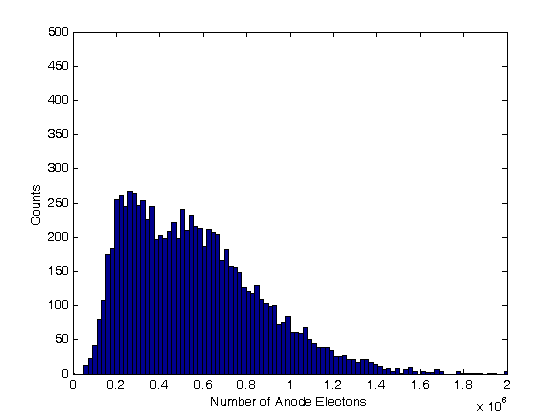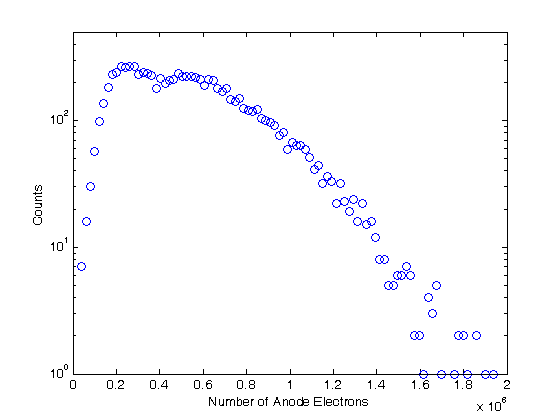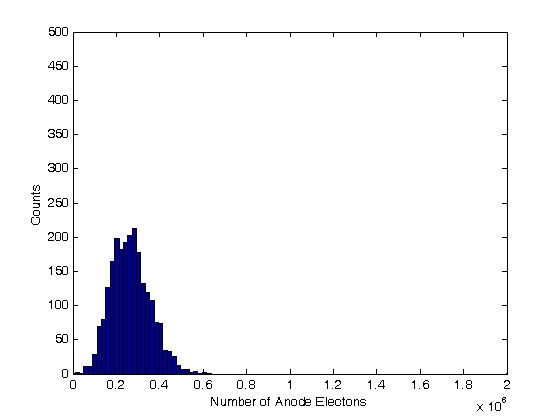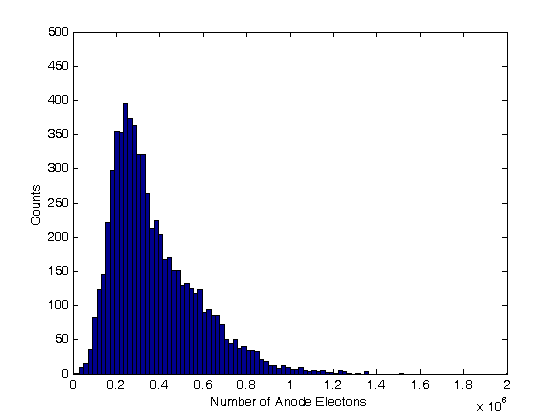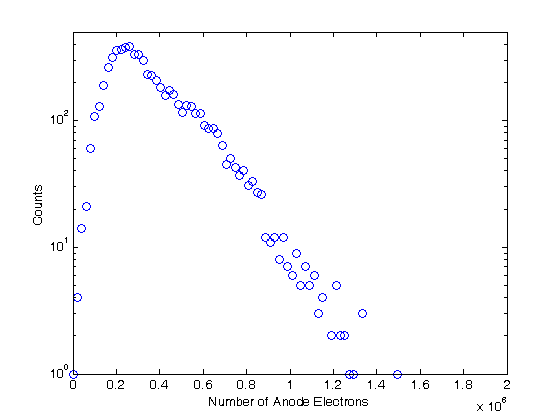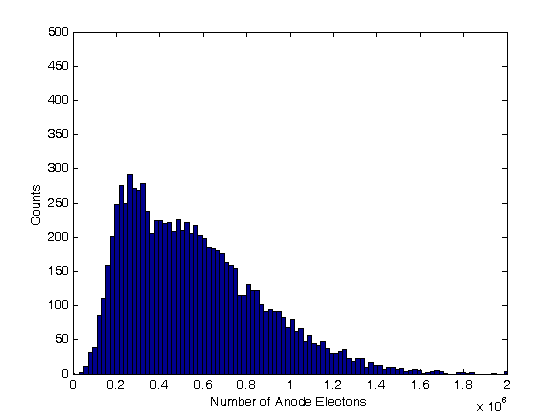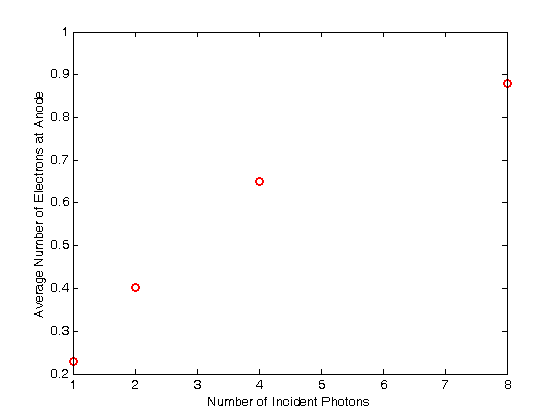% Jake Bobowski % August 16, 2017 % Created using MATLAB R2014a % This tutorial will use Monte Carlo methods to simulate the output of a % Photomultiplier Tube (PMT) once triggered by the detection of one or more % photons. % This example follows notes posted online which you can find at the following % url: http://superk.physics.sunysb.edu/~mcgrew/phy310/lectures/phy310-lecture-06-2007.pdf clearvars % In all Monte Carlo simulations it is necessary to generate random or % pseudo-random numbers. The MATLAB command "rand" generates random % numbers uniformly distributed between zero and one. Note that, to % generate random numbers drawn from a normal distribtuion, you can use % "randn". rand % First, suppose N photons hit the photocathode. Determine the number of % photoelectrons (pe) that are generated. Assume that the incoming light is % 400 nm and that the quantum efficiency of the photocathode is 0.23. %(Following http://superk.physics.sunysb.edu/~mcgrew/phy310/lectures/phy310-lecture-06-2007.pdf) N = 2363; QE = 0.23; pe = 0; for i = 1:N if rand < QE pe = pe +1; end end pe % When an electron with energy E hits a Dynode the average number of % secondary electrons liberated is alpha*E (i.e. number of secondary electrons % is proportional to the energy of the incoming electron) where alpha is a % contant. Since we are counting electrons, the distribution of liberated % electrons follows the Poisson distribution. In MATLAB random numbers % drawn from a Poisson distribution with mean mu are generated using % poissrnd(mu). As an example, below we generate random integers drawn from % a Poisson parent distribtuion with mean 2000. mu = 2000; for i = 1:1000 Ydist(i) = poissrnd(mu); end mean(Ydist) std(Ydist)^2 nbins = 25; hist(Ydist, nbins) xlabel('Y') ylabel('counts') % A photomultiplier tube (PMT) consists of a photocathode followed by a % series of dynodes maintained at different electric potentials and then % finally an anode. When a single photon is incident on the photocathode % it either produces a photoelectron or it doesn't. The probability that % it produces a photoelectron is determined by the quantum efficiency % QE of the photocathode. For this exercise we will assume that QE = 0.23. % If a photoelectron is produced, it is accelerated towards the first dynode by % means of a potential difference. We assume that all electrons, whether % produced at the photocathode or one of the dynodes, start with zero kinetic % energy. Therefore, the energy an electron gains is simply its charge times % the potential difference between its starting and final positions. When % an electron collides with a dynode, secondary electrons are produced. The % average number of secondary electrons produced is proportional to the energy % of the incoming electron. In this problem, we assume that an electron % accelerated through 20 V will, on average, produce one secondary electron % upon colliding with the dynode. Because we are "counting" electrons, the % distribution of secondary electrons generated will follow a Poisson % distribution. Note that the green text are comments and are not part of % the MATLAB script. Comments are started using '%'. QE = 0.23; % Set the quantum efficeincy of the photocathode maxi = 1e4; % Set the number of Monte Carlo iterations dynode = [0, 150, 300, 450, 600, 750, 850]; % Set the number of dynodes and % their voltages cnt = 0; % Set up a counter variable datestr(clock) % Print the time at the simulation was started for i = 1:maxi % This loop runs the Monte Carlo simulation maxi times % (10,000 in this case) if rand < QE % Generate a random number between [0, 1] and check to see % if it's greater than the quantum efficiency cnt = cnt + 1; % Increment cnt by one every time a photoelectron is % produced electrons = 1; % If true, then a photoelectron is produced for j = 1:length(dynode)-1 % This loop will examine the secondary % electrons produced at each of the dynodes mu = electrons*(dynode(j+1)-dynode(j))/20; % Mean number of % electrons generated at a dynode determined from the number of % incoming electons and the energy of the incoming electrons. % One electron accelerated through 20 V will on anverage produce % one electron electrons = electrons + poissrnd(mu); end; dist(cnt) = electrons; % Add the total number of electrons detected at % the anode for this trial to a 'dist' list. 'dist' is indexed by % cnt end; end; datestr(clock) % Print the time at the simulation completed. In Maple this % simulation took my laptop over 8 minutes to complete. Using the same % laptop, it took MATLAB 4 seconds to do the simulation! vpa(length(dist)/maxi) % Determines what fraction of maxi trials actually % produced electrons at the PMT anode. It should come out to be close the % QE = 0.23. mean(dist) % Calculate the mean of the distribution figure(); % Generate a new figure xbins = 0:(2e6/(100-1)):2e6; % Set bin ranges for the histogram. % 100 equally-sized bins fron 0 to 2e6. hist(dist, xbins) % Plot the histgram of the simulated number of anode electrons xlim([0 2e6]) ylim([0 500]) xlabel('Number of Anode Electons') ylabel('Counts') counts = histc(dist, xbins); % Here we use 'histc' to have MATLAB tell us how many % counts there are in each of our 100 bins. figure(); % Start a new figure. semilogy(xbins, counts, 'bo') % Make a semi-log plot of the counts versus % the number of detected anode electrons xlim([0 2e6]) ylim([0 500]) xlabel('Number of Anode Electrons'); ylabel('Counts'); % This next block of code is very similar to the previous. This time, % however, we imagine that there are 8 photons incident on the photocathode % instead of one. Now there can be 0, 1, 2, ..., or 8 photoelectrons % generated and then accelerated towards the first dynode. How does the % distribution of electrons arriving at the anode change? We only require % a relatively minor change to the code to study this problem. Plot the % histograms using the same scale and the same binwidths to make comparisons % with the previous results easy. QE = 0.23; % Set the quantum efficeincy of the photocathode maxi = 1e4; % Set the number of Monte Carlo iterations dynode = [0, 150, 300, 450, 600, 750, 850]; % Set the number of dynodes and % their voltages numPhotons = 8; % Set the number of photons incident on the photocathode. cnt = 0; % Set up a counter variable datestr(clock) % Print the time at the simulation was started for i = 1:maxi % This loop runs the Monte Carlo simulation maxi times % (10,000 in this case) pe = 0; % Set the initial number of photoelectrons to zero. for k = 1:numPhotons % This loop individually steps through each of the % photons incident on the photocathode if rand < QE % Generate a random number between [0, 1] and check to see % if it's greater than the quantum efficiency pe = pe + 1; % Increment pe by one every time a photoelectron is % produced end end if pe > 0 % If there are any photoelectrons, then do something. If there % are not photoelectrons then do nothing cnt = cnt + 1; % Count the number of times we get at least one photoelectron electrons = pe; % Set the initial number of electrons equal to the % number of photoelectrons for j = 1:length(dynode)-1 % This loop will examine the secondary % electrons produced at each of the dynodes mu = electrons*(dynode(j+1)-dynode(j))/20; % Mean number of % electrons generated at a dynode determined from the number of % incoming electons and the energy of the incoming electrons. % One electron accelerated through 20 V will on anverage produce % one electron electrons = electrons + poissrnd(mu); end; dist(cnt) = electrons; % Add the total number of electrons detected at % the anode for this trial to a 'dist' list. 'dist' is indexed by % cnt end; end; datestr(clock) % Print the time at the simulation completed. In Maple this % simulation took my laptop over 8 minutes to complete. Using the same % laptop, it took MATLAB 4 seconds to do the simulation! vpa(length(dist)/maxi) % Determines what fraction of maxi trials actually % produced electrons at the PMT anode. mean(dist) % Calculate the mean of the distribution figure(); % Generate a new figure xbins = 0:(2e6/(100-1)):2e6; % Set bin ranges for the histogram. % 100 equally-sized bins fron 0 to 2e6. hist(dist, xbins) % Plot the histgram of the simulated number of anode electrons xlim([0 2e6]) ylim([0 500]) xlabel('Number of Anode Electons') ylabel('Counts') counts = histc(dist, xbins); % Here we use 'histc' to have MATLAB tell us how many % counts there are in each of our 100 bins. figure(); % Start a new figure. semilogy(xbins, counts, 'bo') % Make a semi-log plot of the counts versus % the number of detected anode electrons xlim([0 2e6]) ylim([0 500]) xlabel('Number of Anode Electrons'); ylabel('Counts'); % Finally, this last block of code runs the same PMT simulation above four % times, each time using a different number of incoming photons [1, 2, 4, 8]. % I put a 'clearvars' at the beginning of the block only to emphasize that this % chunk of code doesn't rely on anything that came before it. These 44 lines % of code will simulate the expected distributions of anode electrons for 4 % difference sets of incoming photons. There real virtue of the Monte Carlo % simulation is that we can now vary properties of the PMT with trivial % modifications to the code below and systematically study the effects. % For example, what if there were mode dynodes? All we have to do is modify % the line dynode:=[0,150,300,450,600,750,800]. Alternatively, we could % keep the number of dynodes fixed and modify the potential applied to the % dynodes. Of course, after making this relatively simple simulation work, % we could make modifications to make it more sophisticated. What if 8 % photons are directed towards the photocathode, but they arrive at slightly % different times. What does the current pulse at the anode look like? % That's not a problem that we'll tackle here, but it does demonstrate the % versitility of the Monte Carlo method. clearvars QE = 0.23; % Set the quantum efficeincy of the photocathode maxi = 1e4; % Set the number of Monte Carlo iterations dynode = [0, 150, 300, 450, 600, 750, 850]; % Set the number of dynodes and % their voltages numPhotons = [1, 2, 4, 8]; % Set the number of photons incident on the % photocathode. We will repeat the simulation for 4 different numners of % incoming photons datestr(clock) % Print the time at the simulation was started for m = 1:length(numPhotons) figure(); % Generate a new figure cnt = 0; % Set up a counter variable for i = 1:maxi % This loop runs the Monte Carlo simulation maxi times % (10,000 in this case) pe = 0; % Set the initial number of photoelectrons to zero. for k = 1:numPhotons(m) % This loop individually steps through each of the % photons incident on the photocathode if rand < QE % Generate a random number between [0, 1] and check to see % if it's greater than the quantum efficiency pe = pe + 1; % Increment pe by one every time a photoelectron is % produced end end if pe > 0 % If there are any photoelectrons, then do something. If there % are not photoelectrons then do nothing cnt = cnt + 1; % Count the number of times we get at least one photoelectron electrons = pe; % Set the initial number of electrons equal to the % number of photoelectrons for j = 1:length(dynode)-1 % This loop will examine the secondary % electrons produced at each of the dynodes mu = electrons*(dynode(j+1)-dynode(j))/20; % Mean number of % electrons generated at a dynode determined from the number of % incoming electons and the energy of the incoming electrons. % One electron accelerated through 20 V will on anverage produce % one electron electrons = electrons + poissrnd(mu); end; dist(cnt) = electrons; % Add the total number of electrons detected at % the anode for this trial to a 'dist' list. 'dist' is indexed by % cnt end; end; m % This code can take some time to execute, so provide some intermediate % outputs to track progress vpa(length(dist)/maxi) % Determines what fraction of maxi trials actually % produced electrons at the PMT anode. mean(dist) % Calculate the mean of the distribution datestr(clock) % Print the time that this iteration of the simulation completed eventsSet{m} = [numPhotons(m), vpa(length(dist)/maxi)];% Keep track of % how many sets of incident photons actually resulted in a signal at % the anode. distSet{m} = dist; % Store the distributions recorded into a set xbins = 0:(2e6/(100-1)):2e6; % Set bin ranges for the histogram. % 100 equally-sized bins fron 0 to 2e6. hist(dist, xbins) % Plot the histgram of the simulated number of anode electrons xlim([0 2e6]) ylim([0 500]) xlabel('Number of Anode Electons') ylabel('Counts') counts = histc(dist, xbins); % Here we use 'histc' to have MATLAB tell us how many % counts there are in each of our 100 bins. figure(); % Start a new figure. semilogy(xbins, counts, 'bo') % Make a semi-log plot of the counts versus % the number of detected anode electrons xlim([0 2e6]) ylim([0 500]) xlabel('Number of Anode Electrons'); ylabel('Counts'); end; % Using the data stored in 'eventsSet', generate a plot of the average number % of electrons detected at the anode versus the number of photons incident % on the photocathode. for i = 1:length(eventsSet) y(i) = eventsSet{i}(2); end figure(); plot(numPhotons, y, 'ro', 'LineWidth', 2) xlabel('Number of Incident Photons') ylabel('Average Number of Electrons at Anode') % Finally, using the distributions stored in the set 'distSet', plot the % simulated distributions for the different numbers of incident photons all on % the same semi-log plot. figure(); hold on; colours = {'ko', 'bo', 'ro', 'go'}; for i = 1:length(numPhotons) counts = histc(distSet{i}, xbins); semilogy(xbins, counts, colours{i}, 'LineWidth', 2) set(gca,'yscale','log') % 'hold on' seems to screw up 'semilogy'. This % line of code puts the y-scale back to a log scale. end box on; xlim([0 2e6]); ylim([0 500]); xlabel('Number of Anode Electrons'); ylabel('Counts'); legend('1 photon', '2 photons', '4 photons', '8 photons'); hold off;
ans =
0.8005
pe =
548
ans =
2.0019e+03
ans =
1.8471e+03
ans =
16-Aug-2017 13:40:22
ans =
16-Aug-2017 13:40:27
ans =
0.2332
ans =
2.6164e+05
ans =
16-Aug-2017 13:40:27
ans =
16-Aug-2017 13:40:45
ans =
0.8765
ans =
5.6099e+05
ans =
16-Aug-2017 13:40:45
m =
1
ans =
0.2294
ans =
2.6544e+05
ans =
16-Aug-2017 13:40:50
m =
2
ans =
0.4018
ans =
2.9810e+05
ans =
16-Aug-2017 13:40:58
m =
3
ans =
0.6498
ans =
3.7532e+05
ans =
16-Aug-2017 13:41:11
m =
4
ans =
0.8804
ans =
5.5660e+05
ans =
16-Aug-2017 13:41:30



